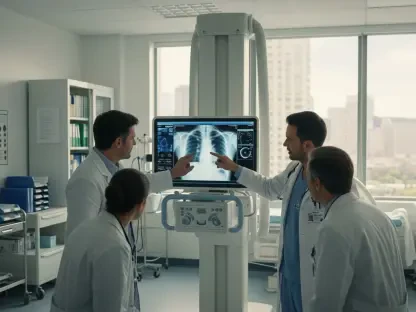Today, we’re thrilled to sit down with Laurent Giraid, a renowned technologist whose expertise in Artificial Intelligence has positioned him at the forefront of innovation in medical imaging. With a deep focus on machine learning, natural language processing, and the ethical implications of AI, Laurent offers invaluable insights into how these technologies are transforming radiology. In this conversation, we’ll explore the evolving role of AI in diagnostic imaging, the challenges radiology departments face in adopting new technologies, and the future possibilities for enhancing patient care through intelligent systems.
How has Artificial Intelligence begun to reshape the field of radiology, particularly in terms of diagnostic accuracy and workflow efficiency?
AI is revolutionizing radiology in ways we couldn’t have imagined a decade ago. On the diagnostic side, algorithms are being trained to detect subtle patterns in imaging data—things like early signs of cancer or minute fractures—that might be missed by the human eye, especially under time pressure. These tools act as a second set of eyes, boosting confidence in diagnoses and sometimes catching things earlier than traditional methods. When it comes to workflow, AI is automating tedious tasks like sorting through hundreds of images in 3D breast tomosynthesis or pulling relevant patient data from prior exams. This saves radiologists significant time, letting them focus on complex cases rather than manual processes. It’s not about replacing radiologists but augmenting their capabilities to handle growing patient volumes, especially in a post-pandemic world where burnout is a real concern.
What are some of the biggest hurdles radiology departments face when integrating AI technologies into their daily operations?
One of the biggest hurdles is integration itself. Many hospitals have legacy systems that weren’t built to handle modern AI applications, so getting these tools to work seamlessly with existing platforms like PACS can be a technical nightmare. Then there’s the issue of trust—radiologists need to feel confident in the AI’s recommendations, which means transparency in how these algorithms make decisions is crucial. Cost is another barrier; while AI promises long-term savings, the upfront investment can be steep for smaller facilities. Lastly, there’s a learning curve. Staff need training to use these tools effectively, and with staffing shortages already a problem, finding time for that can be tough. It’s a complex puzzle, but vendors are starting to address this with app stores and pre-integrated solutions to ease the transition.
How do you see AI addressing the current challenges of staffing shortages and increased patient volumes in radiology departments?
AI has immense potential to bridge the gap here. With staffing shortages, especially post-pandemic, radiologists are stretched thin. AI can take over repetitive tasks like image reconstruction or preliminary reads, allowing radiologists to focus on interpreting complex cases or consulting with patients. For increased patient volumes, AI-driven prioritization tools can flag urgent cases—think a potential stroke or hemorrhage—so they’re reviewed sooner. In rural or underserved areas where specialists are scarce, AI can provide decision support to general practitioners or less experienced readers, ensuring patients still get high-quality care. It’s not a complete fix for staffing issues, but it’s a powerful tool to maximize the impact of the limited workforce we have.
In your opinion, what ethical considerations should guide the development and deployment of AI in medical imaging?
Ethics is at the heart of AI in healthcare, and we can’t overlook it. First, there’s the issue of bias—AI systems are only as good as the data they’re trained on. If that data underrepresents certain populations, the algorithms might perform poorly for those groups, worsening health disparities. Transparency is another big concern; patients and doctors need to understand how AI reaches its conclusions, especially when it influences life-altering decisions. Privacy is non-negotiable—imaging data is sensitive, and robust safeguards must protect it from breaches or misuse. Finally, we must ensure AI doesn’t erode the human element of medicine. It should support, not replace, the radiologist-patient relationship. Striking this balance requires ongoing dialogue between technologists, clinicians, and ethicists to keep patient welfare at the core.
Can you share your thoughts on how AI might evolve to further personalize diagnostic imaging for individual patients in the future?
I think the future of AI in imaging lies in hyper-personalization. Right now, AI can analyze images based on general patterns, but as we integrate more data—like genetic profiles, lifestyle factors, and medical history—AI could tailor diagnostic insights to the individual. Imagine an algorithm that not only spots a lesion but also predicts how likely it is to become malignant based on that patient’s unique risk factors. It could guide screening schedules, suggesting more frequent imaging for high-risk patients while reducing unnecessary scans for others. This kind of precision could optimize care and cut costs. We’re also seeing early work in AI adapting imaging protocols on the fly—adjusting parameters during a scan to get the best image quality for that specific patient. It’s an exciting frontier, but it’ll require robust data integration and strict ethical oversight to get right.
What is your forecast for the role of AI in radiology over the next decade?
I’m optimistic that AI will become an indispensable partner in radiology over the next ten years. We’ll likely see it embedded directly into imaging equipment, optimizing scans in real-time for better image quality with lower radiation doses. Decision-support tools will become more sophisticated, not just flagging abnormalities but offering detailed differential diagnoses tailored to the patient’s full clinical picture. I expect AI to play a bigger role in predictive analytics, forecasting disease progression or treatment outcomes based on imaging trends. Workflow automation will mature, potentially handling entire preliminary reads in low-risk cases, freeing radiologists for more complex work. But the key will be balance—ensuring AI enhances rather than overshadows clinical judgment. If we can navigate the ethical and technical challenges, AI could truly transform radiology into a more efficient, precise, and patient-centered field.









